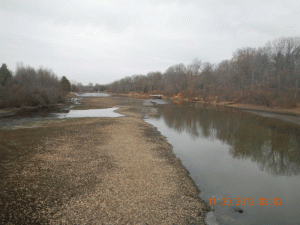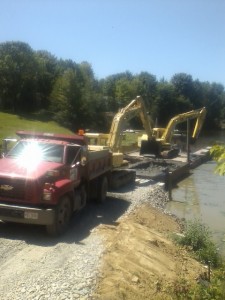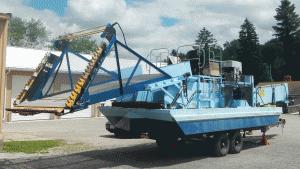The Economics of Lakes – Dollars and $ense
 By Pamela Hoover – Lake Management Committee
By Pamela Hoover – Lake Management Committee
We are all here, in beautiful Roaming Shores Village (RSV), for a variety of reasons. Some of us bought in RSV first and foremost for the beautiful lake and the related recreational activity it affords. Others of us bought in RSV for an affordable home, possibly a starter home, perhaps close to family. Living in RSV provides important public health and safety benefits, including a dedicated police force, road maintenance, public water and sewer. And as RSV residents, we have access to an assemblage of quality-of-life enhancing amenities unique in this area – numerous well-maintained parks, many with beautiful water views, groomed beaches, lake-front pools, playgrounds with fun and safe structures, a year-round clubhouse, tennis courts, a groomed baseball field, and basketball courts. Did I miss anything? All of this for annual fees less than a family YMCA membership!!
In an effort to continue improving our private lake community we have researched the relationship between lake health and property values. Multiple studies done in Maine and Minnesota have demonstrated a significant and positive correlation between lake health and community property values and the resultant tax revenue. Findings included:
- An improvement of 3 feet in depth of water clarity could affect property values by approximately $200 per frontage foot, or $16,000 for a single lake front lot. (1, 2, 3, 4, 5)
- Declining water clarity was shown to account for 10-20% drop in selling price. (1, 2, 3, 4, 5)
- A 3-foot decline in water clarity was shown to decrease property values by approximately 5%. (2, 4, 5)
- Grand Lake St. Mary’s (Ohio) experienced an estimated 14% decrease in property values in a two year period, with 6% of that decline directly attributed to the conditions of Grand Lake St. Mary’s. (6)
The presence of an attractive and usable lake supports home values and the tax base, which, along with the Association dues, fund the services that help to protect our health and safety, and provide amenities that make Roaming Shores Village living so special. Regardless of where and why we purchased a home in the Village, good water care practices benefit all of us. The Rome Rock Association Lake Management website http://www.roamingshores.org/RRA1/ has numerous articles and resources to help residents to be responsible lake water quality stewards.
Here is the link to our article history:
http://www.roamingshores.org/RRA1/category/sediment-control-sub-committee/
A few article titles are,
Washing Your Boat – An alternative approach
Landscaping Options – Buffer Zones
Spring Cleaning (Lake-Responsible Style)
Be Lake Responsible – LOVE THE LAKE
References:
-
Protecting waterfront property values, local tax base http://mrbdc.mnsu.edu/sites/mrbdc.mnsu.edu/files/public/org/lakecrystal/pdf/lakeshore_factsheets/protecting_lakefront_propvalues.pdf
-
Economics of Shoreline Protection http://www.uwsp.edu/cnr-ap/UWEXLakes/Documents/ecology/shoreland/background/the_economics_of_shoreline_protection.pdf
3 Schueler, T.R. and H.K. Holland, editors. 2000. The Practice of Watershed Protection. The Center for Watershed Protection, Ellicott City, MD
4. Lake Economics http://lakeripley1.homestead.com/files/lake_economics.pdf
-
Maine Department of Environmental Protection, Lake Assessment Program. 2000. More on Dollars and Sense: The Economic Impact of Lake Use and Water Quality.
-
Economic Impact of Grand Lake St. Mary’s http://www.lakeimprovement.com/sites/default/files/edseries/economy/economy.html
Additional Resources:
The Economics of Lakes - Dollars and $ense http://www.maine.gov/dep/water/lakes/research.html
Health Lakes and Higher Property Values http://water.epa.gov/type/lakes/upload/healthy_lakes_and_higher_property_values.pdf
For all Ohio, Algal Blooms and Legislation
 By Tim Langer, David Ernes and Richard D. Gainar, CEBS – Lake Management Committee
By Tim Langer, David Ernes and Richard D. Gainar, CEBS – Lake Management Committee
If you have seen the news articles and reports about the severity of algal blooms in Lake Erie and their predictions, you can imagine how much attention this topic is getting at the State and Federal level. As your Lake Management Committee has mentioned before, most of the regulations and training are focused for Northwest Ohio and those watersheds feeding Lake Erie’s Western Basin. Within the past six (6) months both the Ohio Senate and Ohio House of Representatives have passed legislation, Senate Bill 1 and House Bill 61 respectively. Unfortunately, both are aimed at the Western Basin watersheds.
Why does it have to be only Northwestern Ohio? It doesn’t! A way to influence and express your viewpoint is to contact those individuals we elected. If you think elected officials pay little or no attention to your letters and phone calls, think again. A concise, thoughtful letter from their constituents has a significant influence on elected lawmakers. Your vote helps elect them — or not — and that fact alone carries a lot of weight. A staff worker may read and answer your letter because hundreds of letters are sometimes received. But, be assured that your point is communicated and will influence the lawmaker. If you fail to make your interests known, your thoughts will not be represented.
We need to suggest to our Legislators that the current legislation and future legislation be modified to include all watersheds that feed Lake Erie, including ours. Therefore, the LMC asks that you help us and write to your state representatives and ask that they consider this change. A few suggestions for content are shown below.
- The intent is to improve water quality in Lake Erie, but current legislation ignores most of the Ohio coastline. All watersheds, which feed the lake, can affect the overall Lake Erie water quality.
- As a resident of Ohio’s largest private lake, we would also like to insure that the water quality is protected where we live. Our community is actively addressing fertilizers and cleaners that we control. We cannot affect the farming practices, which have the greatest effect on our lake.
- Although the blooms are currently worse on the western basin, that does not mean that, with time, the problem can extend to the rest of the lake, especially if nothing is done in the central or eastern watersheds.
What to write a letter? We are here to help! It’s usually best to send letters to your state representatives for local issues such as improving water quality. Our Ohio District 99 House representative and Ohio District 32 Senate representatives are:
| Salutation for Ohio House rep: The Honorable John Patterson District 99 77 S. High St 10th Floor Columbus, OH 43215Dear Representative: |
Salutation for Ohio Senate rep: The Honorable Capri S. Cafaro District 32 Senate Building 1 Capitol Square, Ground Floor Columbus, OH 43215Dear Senator: |
Your letter does not have to be long or eloquent. It also helps personalize your letter by providing some non-emotional detail and facts in your own words. If certain legislation is involved, cite the title or number whenever possible and explain how it affects you and others. Be sure to include your name and address. Keep it short and simple and include evidence to support your position. Close by requesting the action you want taken: a vote for or against a bill, or change in general policy. Don’t forget to thank them for taking time to read your letter.
Questions? Please email myself at: timattheshores@gmail.com. It’s believed your letters in support of keeping nutrients and sediment in the fields and not in our waterways will have a significant benefit for Lake Roaming Rock. If you agree with us, pick up a pen. For the price of a postage stamp, you can affect our future.
BE LAKE RESPONSIBLE
Lake to be Lowered This Year
Update: The beginning date of draw-down has been moved to November 2, 2015
At the last Board of Directors meeting, the Board voted to lower the lake beginning on October 19th November 2, 2015. Many property owners use this opportunity to perform work on their docks and seawalls.
Boaters, please note this date and plan to have your boat off the water shortly after the lowering begins.
Hopefully the weather will cooperate this year.
Stormwater Runoff

By Richard D. Gainar, CEBS – Lake Management Committee
Storm water runoff is rainwater flowing from impervious areas such as roofs, roadways, and parking lots. Stormwater runoff carries pollutants such as motor oil, gasoline, grease, pesticides, fertilizers, and sediment just to name a few. Since most of our storm drains and ditches discharge to surface waters, these pollutants are washed by the runoff directly into our lake and streams.
Well, who cares? You should care! Our lake is a magnet for residents who enjoy fishing, boating, swimming, skiing or simply enjoying the esthetics. In addition, our lake is home to numerous types of wildlife including several threatened and endangered species.
So, what can I do to make a difference? You can help control pollution by planting trees, slope gardens and yards so that the water stays on your property. Use porous materials such as gravel beds or turf blocks rather than paved areas. Wash vehicles on grassy areas to let water seep into the ground. Properly recycle used oils and antifreeze. Don’t dump anything into a storm water drain and ditch. Use pesticides only when absolutely necessary. Use the right amount of fertilizer at the right time and properly dispose of all hazardous waste. Keep disturbances of natural ground surfaces to a minimum, and maintain your vehicle so it doesn’t drip oil, grease, or other fluids.
We all love our lake and must try to be good stewards. Be lake responsible.
What is that green stuff in the lake?
 By David Ernes – Lake Management Committee
By David Ernes – Lake Management Committee
If you recall, not all algae are bad. Green algae usually pose no significant concerns, other than their aesthetic appearance. On the other hand, blue-green algae have the potential to generate toxins that can be harmful. How does one decide if what they see is green algae or blue-green algae? Unfortunately, the only accurate method is to examine the organism under magnification and assess its structure by experts in this type of analysis.
In spite of this, there are some general features that can help to differentiate the types of algae. Most informational articles include a significant number of pictures showing visually what each type looks like. One good source showing both types can be found on a New York web site (www.dec.ny.gov/chemical/81962.html).
Generally, green algae often look like floating rafts, and may appear as if it were a bubbling scum on the surface of the water that may entangle with other plants. There is also a type of green algae that is stringy, or silky and coat rocks and other areas. Duckweed looks like small disks and tend to clump into areas.
Blue-green algae, on the other hand, can appear as green streaks, as spilled paint or pea soup. It can also form as small dots that disperse when disturbed. Others types may look like grass clippings. Blue-green algae are often accompanied by a foul odor (described in some articles as “pigpen” odor).
Other observations one may see in the lake are not algae at all. You may recall a previous article about bryozoans, which are a beneficial organism. You may also see what appears to be foam on the water. This is caused by decomposition products from algae and other plants which, due to wind or agitation, can cause the foam. It can even be seen as parallel streaks in the lake in the direction of the wind. This is harmless and a natural phenomenon in lakes.
Common sense tells us not to swim in any waters that contain unusual amounts of algae. It is best just to avoid contact to insure that you minimize any adverse effects. When in doubt, choose a different spot or visit one of our inviting pools. Please enjoy our beautiful lake and have a safe summer.
BE LAKE RESPONSIBLE
Dredging has begun in Fisherman’s Cove
The RRA Maintenance crew is now in Fisherman’s Cove for dredging. Fisherman’s Cove is the cove that had the most sedimentation according to the study performed by Enviroscience. It is located between Morning Star Dr and Belvista on the East side of the lake. Our crew will be dredging this cove for the duration of the year.
Harvester Trade
This week, RRA Maintenance Director Dan Mullins made an even trade of our Aqua Cat Weed Harvester to another lake community for an Aquarius 420 Harvester. This new harvester is the same model of Aquarius Harvester that was replaced in 2013, only newer. This model of harvester will handle our lake as it did in the past. The off-loading conveyer from the old Aquarius Harvester is still in the possession of the maintenance department and will work with the newer machine.
The crew is going over the unit before it’s launched and you will see it on the water as soon as the weeds begin to grow!
The lake community who received our old harvester in the trade will be using it for debris removal on their lake.
Be Part of the Solution
Have you been paying attention to the lake over the years? Do you look out your window, or from your deck, your dock, or your watercraft and see things that concern you? Are you worried when you see mud-brown water, weeds, or algae? Do you worry even more about the possibility of toxins resulting from algae growth? If you do worry about these things—about the quality of our lake water, what have you been doing about it: Keeping your worries to yourself? Complaining about it to your friends and neighbors? Standing up at Board meetings and voicing your concerns? Deciding to move elsewhere? Sure, you can do all of these things; but are any of them really helping to solve the problem? Are any of them really actions that may improve the quality of our lake water? Most likely they are not. There are actions you could take, however, which will help with the problems of water quality. Here are some suggestions.
- Educate yourself by reading the Shores News articles written by Lake Management Committee members and by accessing and reading information on the RomeRock Association website relating to water quality. You can identify the articles by our Love the Lake logo.
- Follow suggestions in the articles and on the website for: using phosphorous-free lawn care products and lake-friendly cleaning products; constructing a buffer zone or other means to counteract shoreline erosion; planting a rain garden; and picking up after your pet.
- Do your best to keep your own leaves and yard waste out of the lake.
- Use the information provided by the Lake Management Committee to contact your state congressmen or congresswomen and lobby them to pass legislation helping to control farmland runoff into our lake’s watershed. To learn more, visit the Sediment and Nutrient Control website under the Lake Management Tab and look for our February 19, 2015 article. http://www.roamingshores.org/RRA1/category/sediment-control-sub-committee/
- Get involved. Join the Lake Management Sediment and Nutrient Control Sub-Committee. Contact the Association office or visit the RomeRock Association website for meeting times. Or send an email requesting information to IT@roamingshores.org.
- Encourage your friends and neighbors to follow the first five suggestions!!
Take another look at our lake. Decide right now to start following the above suggestions. Be one of those people in the community who becomes part of the solution to the problems of water quality. Remember to Be Lake Responsible and Love the Lake.
Landscape Fabrics
 By Tim Langer – Lake Management Committee
By Tim Langer – Lake Management Committee
Landscape fabrics are used to prevent weed growth while still allowing air, oxygen and water to flow to and from the soil. These fabrics are a chemical-free way to prevent weed growth, endearing them to eco-friendly residents and homeowners at Roaming Shores. Landscape fabrics, once laid, are a far less labor-intensive method to prevent weed growth, as they can be effective for several years, during which homeowners can expect to perform little or no maintenance. Less tilling of soil will limit the amount of soil erosion. In addition, many homeowners prefer landscape fabrics because they can help soil effectively maintain moisture during dry periods when gardens might otherwise be highly susceptible to drought. Once down, landscape fabric can be covered with mulch to add aesthetic appeal. Each of us doing our part helps protect our greatest resource, Lake Roaming Rock.
Remember to Love the Lake and BE LAKE RESPONSIBLE!
Calling all Green Thumbs
By Ti m Langer – Lake Management Committee
m Langer – Lake Management Committee
Recently I’ve been thinking of other ways I can beautify my yard while also helping protect our communities greatest resource. My research led me to a rain garden.
What is a Rain Garden you may ask? Well, a rain garden is an attractive, landscaped area planted with perennial native plants, which don’t mind getting “wet feet.” They are beautiful gardens, built in depressions, which are designed to capture and filter storm water runoff from impervious surfaces around the home, such as rooftops and driveways. Some of the benefits of rain gardens include their ability to perform the following functions: Help keep water clean by filtering storm water runoff before it enters our lake. Help alleviate problems associated with flooding and drainage. Enhance the beauty of individual yards and our community. Provide habitat and food for wildlife including birds and butterflies.
Why do we need Rain Gardens? As we continue to develop the Village of Roaming Shores, impervious surfaces such as rooftops, driveways and roads shed water. This increases the opportunity for pollution to flow directly into our lake. Some examples of those pollutants include fertilizer, pesticides, pet waste, grass clippings and yard debris. An easy way to help keep these pollutants out of our lake is to install a rain garden.
Installing a rain garden can be a fairly simple process, involving a shovel and a bit of physical energy. The size and style of your rain garden will depend on a number of factors including: the size of your yard, whether you are trying to create a formal or informal looking garden, and the amount of money you want to spend. Remember, you can never have a rain garden which is too small large or too small. Any size rain garden can contribute to solving water quality problems and will be a beautiful addition to your property!
shovel and a bit of physical energy. The size and style of your rain garden will depend on a number of factors including: the size of your yard, whether you are trying to create a formal or informal looking garden, and the amount of money you want to spend. Remember, you can never have a rain garden which is too small large or too small. Any size rain garden can contribute to solving water quality problems and will be a beautiful addition to your property!
Go native! Using native plants in your rain garden is highly recommended. The benefits of using native plants in your garden are multiple but a few key benefits include their ability to adapt to our local weather and soil conditions and their ability to attract local butterflies and birds. Remember to avoid planting invasive exotic species. While they will grow, they do not belong here.
As I have learned and I hope you do too, a rain garden may be the perfect addition to your yard’s landscape and mine and to our beautiful lake community. If you are interested in learning more about rain gardens, please read the complete Rain Garden Manual by visiting the Geauga County Soil and Water District website www.geaugaswcd.com and look for the Manual under their Publications tab.
Love the Lake and BE LAKE RESPONSIBLE!
Source: Rain Garden Manual for Homeowners, Copyright 2006 Geauga Soil and Water Conservation District



